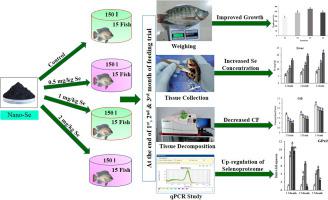Comparative Biochemistry and Physiology C: Toxicology & Pharmacology ( IF 3.9 ) Pub Date : 2020-10-04 , DOI: 10.1016/j.cbpc.2020.108907 S S Rathore 1 , H S Murthy 1 , S K Girisha 2 , M S Nithin 2 , S Nasren 1 , M A A Mamun 1 , T G Puneeth 2 , K Rakesh 1 , B T N Kumar 3 , M Pai 1

|
Selenium (Se), a fundamental element of nutrigenomic science in fish nutrition, was used to investigate its impact on selenoproteome expression and Se regulation in tilapia. Different concentrations (T1 – 0, T2 – 0.5, T3 – 1.0 and T4 – 2.0 mg/kg of feed) of dietary nano-Se were incorporated in the diets of monosex Nile tilapia. A total of 180 tilapia fingerlings with initial weight (15.73 ± 0.05 g) were stocked in 150 L capacity FRP tanks categorized into four diet groups with triplicate each for a feeding trial of 90 days. At the end of first, second and third months of the feeding trial, gill, liver, kidney and muscle tissues were harvested to evaluate the effect on the kinetics of Se bioaccumulation and assimilation as well as immune-regulated selenoprotein transcripts (GPx2, SelJ, SelL, SelK, SelS, SelW and Sepp1a) and their synthesis factors (SPS1 and Scly). The findings depicted that significantly (p < 0.05) higher weight gain was found in the diet supplemented with 1.0 mg/kg of nano-Se. The theory of second-order polynomial regression supported the same. The liver showed significantly (p < 0.05) higher Se accumulation and concentration factor among the harvested tissues in a different timeline. All the selected immune-regulated selenoproteins and synthesis factors in different fish tissues showed significantly (p < 0.05) up-regulation in the diet supplemented with 1.0 mg/kg of nano-Se for the second month. Therefore, the present findings suggested that the supplementation of nano-Se could be more effective for improved growth, better selenium regulation and expression of immune-regulated selenoproteins in the fish model.
中文翻译:

鱼饲料中纳米硒的补充:对单性尼罗罗非鱼(Oreochromis niloticus)中硒同化和免疫调节硒蛋白表达的影响
硒(Se)是鱼类营养学中营养学的基本元素,用于研究其对罗非鱼中硒蛋白表达和硒调控的影响。不同浓度(T 1 – 0,T 2 – 0.5,T 3 – 1.0和T 4–单性尼罗河罗非鱼日粮中添加了2.0 mg / kg饲料的日粮纳米硒。将总共180头初始重量(15.73±0.05 g)的罗非鱼鱼种放到150升容量的FRP储罐中,该储罐分为四个饮食组,每组一式三份,进行90天的喂养试验。在喂养试验的第一,第二和第三个月末,收获were,肝,肾和肌肉组织,以评估其对硒生物积累和同化以及免疫调节的硒蛋白转录物(GPx2,SelJ, SelL,SelK,SelS,SelW和Sepp1a)及其合成因子(SPS1和Scly)。描绘了显著的调查结果(p 补充1.0 mg / kg纳米硒的饮食中,发现体重增加<0.05)。二阶多项式回归的理论也支持这一点。 在不同的时间轴中,肝脏在收获的组织中显示出明显较高的(p <0.05)硒积累和富集因子。 在第二个月中,在补充有1.0 mg / kg纳米硒的日粮中,所有鱼组织中所有选定的免疫调节的硒蛋白和合成因子均显示出明显的上调(p <0.05)。因此,本研究结果表明,在鱼模型中补充纳米硒可以更有效地改善生长,改善硒的调节和免疫调节硒蛋白的表达。











































 京公网安备 11010802027423号
京公网安备 11010802027423号